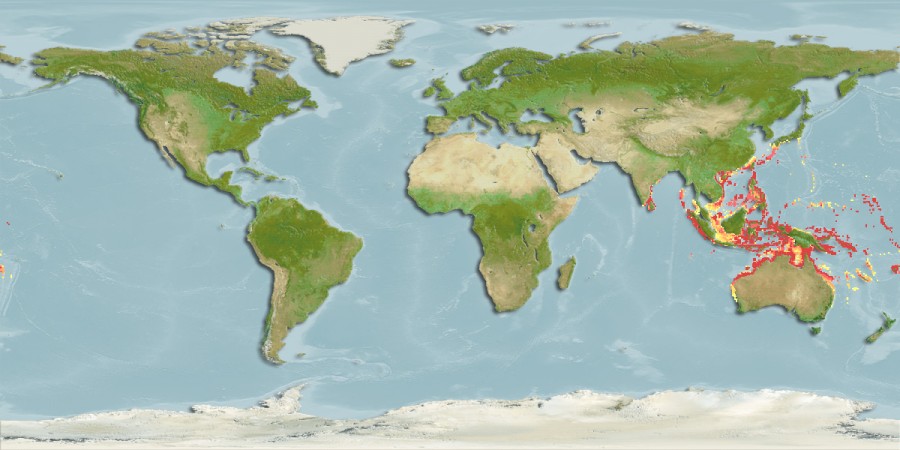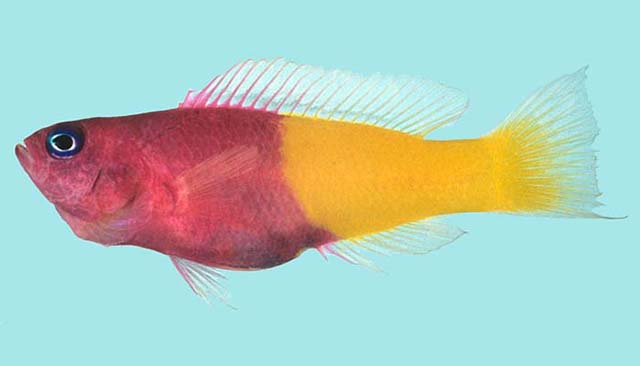Pictichromis
paccagnellorum
(Axelrod,
1973)
Royal dottyback
View all media / Upload your photos and videos
Expand all
Classification / Names
Teleostei (teleosts) > Ovalentaria/misc (Various families in series Ovalentaria) >
Pseudochromidae (Dottybacks)
> Pseudochrominae
Etymology: Pictichromis: Name from Latin pictus meaning painted or colored, and Greek Chromis, a genus of pomacentrid, used as the stem for other fish genera; alludes to the bright live colorations of the included species (Ref. 81967).
Environment / milieu / depth range / climate zone / distribution range
Distribution
Western Pacific: Indonesia (Java and Sulawesi) to Vanuatu; Palau in Micronesia.
Maps

Pictichromis paccagnellorum / Native range
AquaMaps Data sources:
GBIF
OBIS
This map was computer-generated and has not yet been reviewed.

Pictichromis paccagnellorum / Suitable habitat
AquaMaps Data sources:
GBIF
OBIS
This map was computer-generated and has not yet been reviewed.

Pictichromis paccagnellorum / Point map
AquaMaps Data sources:
GBIF
OBIS
This map was computer-generated and has not yet been reviewed.

Pictichromis paccagnellorum / Year 2050
AquaMaps Data sources:
GBIF
OBIS
This map was computer-generated and has not yet been reviewed.
Size / Weight / Age
Max length: 7.0 cm TL male/unsexed (Ref. 2334).
Short description
Dorsal spines (total): 3; Dorsal soft rays (total): 21 - 22; Anal spines: 3; Anal soft rays: 11 - 13. Description: Characterized by magenta color of head and front half of body, yellow posteriorly; variable proportion of magenta and yellow color; anterior lateral line scales 15-21; predorsal scales 15-18; depth of body 27.6-32.0% of SL (Ref. 90102).
Biology
Main reference
Kailola, P.J. 1987 The fishes of Papua New Guinea: a revised and annotated checklist. Vol. II Scorpaenidae to Callionymidae. Research Bulletin No. 41, Research Section, Dept. of Fisheries and Marine Resources, Papua New Guinea. (Ref. 6192)
IUCN Red List Status (Ref. 125652)
Least Concern (LC); date assessed: March 10 2015
CITES (Ref. 123416)
Not Evaluated
CMS (Ref. 116361)
Not Evaluated
Threat to humans
Harmless
More information
- Countries
- FAO areas
- Ecosystems
- Occurrences
- Introductions
- Stocks
- Ecology
- Diet
- Food items
- Food consumption
- Ration
- Common names
- Synonyms
- Metabolism
- Predators
- Ecotoxicology
- Reproduction
- Maturity
- Spawning
- Spawning aggregation
- Fecundity
- Eggs
- Egg development
- Age/Size
- Growth
- Length-weight
- Length-length
- Length-frequencies
- Morphometrics
- Morphology
- Larvae
- Larval dynamics
- Recruitment
- Abundance
- References
- Aquaculture
- Aquaculture profile
- Strains
- Genetics
- Allele frequencies
- Heritability
- Diseases
- Processing
- Mass conversion
- Vision
- Pictures
- Stamps, Coins Misc.
- Sounds
- Ciguatera
- Speed
- Swim. type
- Gill area
- Otoliths
- Brains
Estimates based on models
Preferred temperature (Ref. 123201): 25.8 - 29.3, mean 28.6 °C (based on 1787 cells).
Phylogenetic diversity index (Ref. 82804): PD50 = 0.5039 [Uniqueness, from 0.5 = low to 2.0 = high].
Bayesian length-weight: a=0.00490 (0.00187 - 0.01281), b=3.11 (2.88 - 3.34), in cm total length, based on LWR estimates for this (Sub)family-body shape (Ref. 93245).
Trophic level (Ref. 69278): 3.5 ±0.5 se; Based on food items.
Resilience (Ref. 120179): High, minimum population doubling time less than 15 months ().
Fishing vulnerability (Ref. 59153): Low vulnerability (10 of 100).
Nutrients (Ref. 124155): Calcium = 172 [87, 288] mg/100g; Iron = 0.873 [0.509, 1.490] mg/100g; Protein = 18.3 [17.2, 19.4] %; Omega3 = 0.117 [0.064, 0.211] g/100g; Selenium = 28.2 [12.5, 62.5] μg/100g; VitaminA = 145 [46, 446] μg/100g; Zinc = 2.13 [1.39, 3.08] mg/100g (wet weight);




